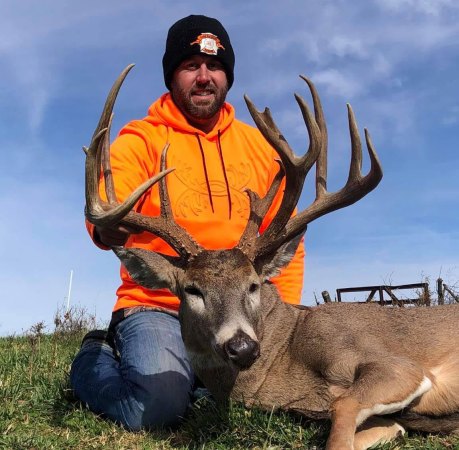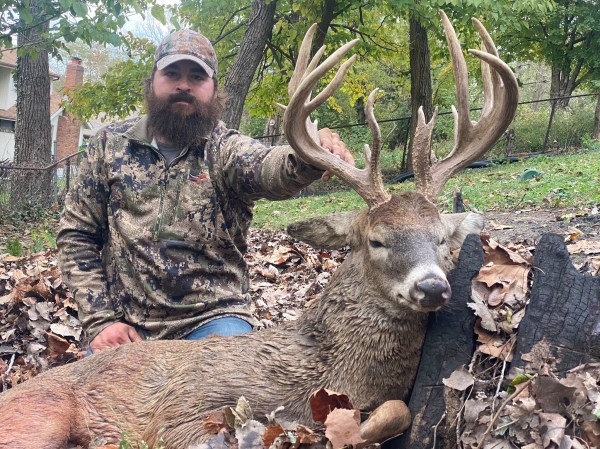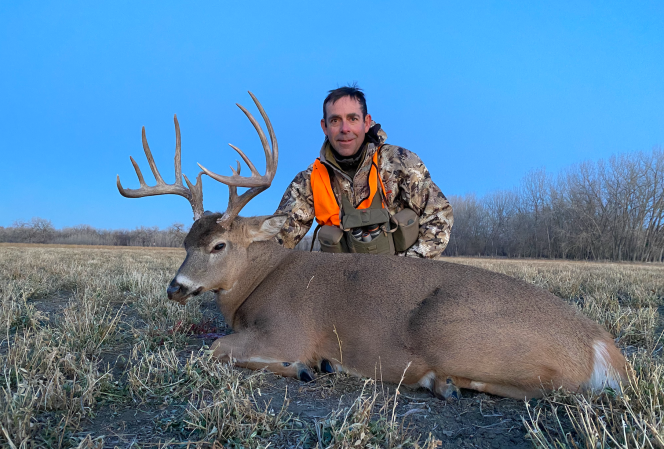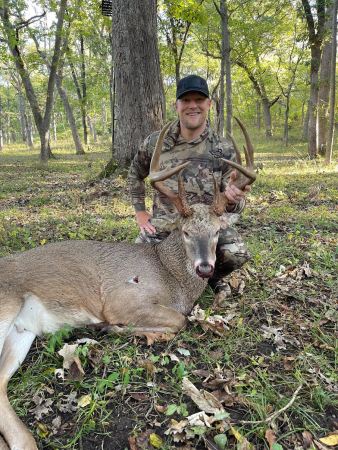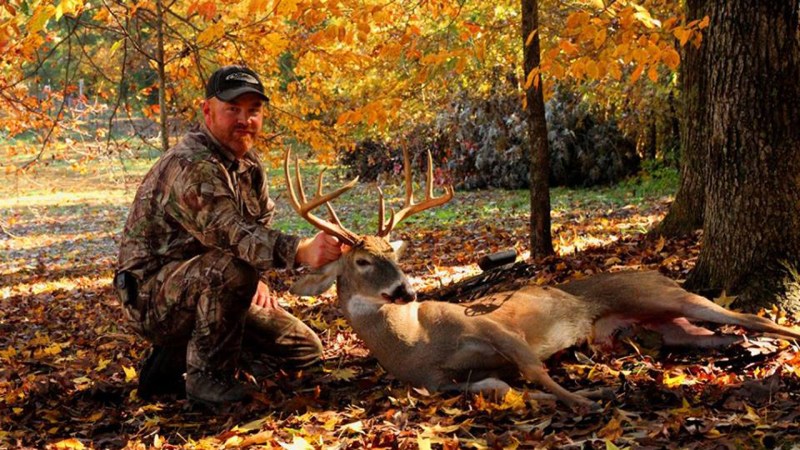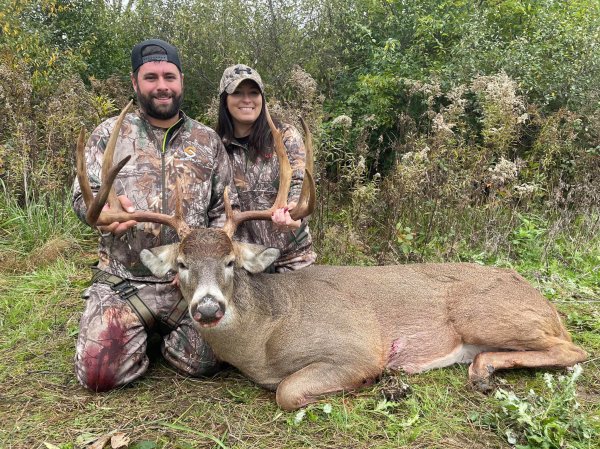At Home in the Timber: Dogged determination in an opening-day snowstorm
For dyed-in-the-wool deer trackers, Christmas morning was to arrive a month early. Snow was forecast for Sunday—the day prior to opening day of deer season. Eager to get on a buck track, I woke up in anticipation of the proverbial white blanket. What I got instead was a wet one—bare ground. The storm had pulled east and the snow would not make its way into my northwestern Maine deer woods. I paced the floor hoping the weatherman might be wrong, but by evening I had just about given up hope. If there was a buck track to be found near home, I’d need to find its maker standing directly in it.
By 9 p.m., word of a fresh 5 inches in Mt. Katahdin to the north buoyed my hopes. By 3:30 the next morning, I was on the road. I hit the northern Maine snow line just at daybreak. I was anxious to find a track. These were unfamiliar deer woods, but in speaking with those who had hunted the area over the years, I formulated a plan. I opened my gazetteer to study the terrain a bit more closely.

Because mature bucks don’t travel very far early in the season in an effort to store energy reserves for the upcoming rut, I knew that finding a fresh track might be difficult. First, I drove an old logging road up the mountain to no avail before heading farther north toward Baxter State Park. The area features huge stretches of roadless, isolated timber—my favorite type of place to track deer. I drove to the end of an old cutover road, entered the truck’s coordinates into my GPS, and headed east. Just 50 yards down the skidder road, I hit paydirt—the telltale dimples of a buck track half full of snow. The game was on.
As I followed the track, which meandered through an old softwood cutting, it began to look fresher. Although I could tell that I was likely on a young 2 ½-year-old buck, I decided to stay on it. Buck paths in the big woods will often cross, and the hope that I might find the trail of an older deer intensified the adrenaline rush. Near a cedar bog and new logging cut, the straight-line trail began to wander. When I spotted feeding sign, I knew that I was closing the distance and slowed down to sneak mode. Just 100 yards farther, the buck flushed from a cluster of young fir trees. After stopping him in a clearing with a loud snort, I looked him over. He was indeed a young buck, with high, narrow, odd-looking antlers. I filmed him for a few minutes with my video camera before he bounded off out of sight.

Turning east again, I continued along with my original plan, finally cutting another track about a quarter mile farther. Though the hoofprints were filled with an inch of snow, I knew from their drag marks that they had been left by a big, mature buck—and he was laying down scrapes as he went. In a hardwood cut, there was more fresh sign where he had chased two feeding does around before heading back into the old-growth woods once more. As he moved along, he made several more scrapes, rubbed his antlers on a brown ash tree, and then abruptly bedded down. Often, bucks will feed before bedding down, which puts me on high alert.
Although the buck’s bed was frozen by the time I reached it, the track leading from it was crisp. It was clear that the buck I was on would make the magic 200-pound (when field-dressed) mark. Whereas deer hunters in most places talk of antler score, in Maine it’s all about the weight. He began feeding as soon as he left his bed—just a nip here and there. I sensed that he wanted to rest again somewhere nearby, since he was at the tail end of his nightly run. Just 30 yards farther, he fed around a blowdown and bedded again. Now I was in super-sneak mode, scouring the brush everywhere for any sign of him. Taking one halting step at a time and dissecting every inch of the woods with my eyes, I eased around the low-hanging limbs of a small spruce. A mere 30 yards away, antlers and ears poked above a blowndown log. Although most bucks bed down facing their backtrack, this one was looking away—with a rack stretching well past his ears. Using the barrel of my Remington 7600, I pushed down the limbs of the spruce, put the bead on buck’s neck, and sent the 180-grainer on its way. With little commotion, the buck merely rolled over in his bed. I eased over to where he was to find a beautiful Maine big-woods buck breathing his last. I sat down and thanked the good Lord for providing me with this buck.
It was nearly noon, but by 3:30 I had managed to drag the old boy through a mile of timber and back to the truck. On the drive home I replayed the events of the day—a three-hour drive into unfamiliar woods to shoot a giant buck. Many hunters might not understand what motivated me, but for serious buck trackers, it’s simply the way it is done.
— Hal Blood
Double Trouble: Two-timing a monster buck
Rustling leaves, breaking sticks—it was getting louder, and heading our way. In northern New England, the sounds could be made by either a moose or a deer. When an ivory rack appeared inches off the ground, seemingly weaving its way through a dense mixture of pin-cherry, beech, and aspen saplings, my hunting partner, Jeff Ladue, and I raised our rifles simultaneously. But as quickly as the antlers had appeared, they were gone. We lowered our guns. looked at each other, and shook our heads. Neither one of us had gotten a clear shot at the buck.
Two days later, we awakened to 3 inches of fresh, powdery snow. It was a morning that deer trackers refer to as a “killing day.”
The headlights of Jeff’s Jeep reflected off a white landscape as we putted our way north 17 miles along a narrow, rutted log road. In darkness, I set my GPS to mark our location. We had about a 2-mile trek to the cutover forests where that huge buck had eluded us. Wearing a lightweight flannel shirt and a wool jacket, my body’s initial morning chill quickly turned to sweat. Cold weather, however, was not the challenge today; it was more the rugged terrain ahead.
We fought through a tangle of berry bushes and balsam fir blowdowns for a few hundred yards. The rest of the walk was on flat ground and relatively easy on a logging skid road. It was no longer passable by vehicle, but plenty of moose traveling along it had created a path. Within a quarter mile of our destination, we struck our first track. It was barely visible in the early light. About an inch of snow had fallen into it. Big and wide in back, the long, staggered stride of the tracks indicted one thing: a mature buck.
We followed, zigzagging into the softwood swamp, crossing several scrapes along the way. The deer had stopped at each one, leaving behind a single hoofprint in the snow, along with a few drops of urine. We kept a fast pace. Then, right there in front of us was what every deer hunter lives to see—an 8-inch spruce shredded from ground to waist level. Strips of fresh tree bark spewed over the base of a young pine. Pitch oozed from the bark.

On high alert, we carefully side-stepped branches in our path. Shortly, the once-3-foot, toe-dragging stride lengthened to 5 feet, though there was no indication that we had jumped him. This rutting buck was heading for new country, perhaps one with a doe in heat in it.
We slung our carbines over our shoulders and picked up the pace, following the buck as he beelined out of the swamp and up a steep, hardwood ridge. Partway up, I bent over to catch my breath when just above me, two large deer bolted. We walked up to the narrow shelf, guns readied. There in the snow were two deer beds. One was extraordinarily long, about the length of a small dining room table. You could see clearly the rounded toes of the bigger deer, often a good sign of an older ridge runner. It was still early, 9:30, and we had a good part of the day to catch up.
One set of tracks left discernable bounding marks and the other left long-spaced prints as we followed them, traversing up the mountainside. Within a half mile, the tracks swung uphill, following a small brook that flowed from a notch between two peaks. Reaching the top, winded and hot, I noticed both sets of deer tracks shortened to a walk. We continued to speed track, leaving the open hillside of yellow birches and red maples to work dense pole-sized spruces and balsam firs.
The deer showed no sign of slowing, so neither did we. Just before pitching down the backside of the mountain, the woods opened up slightly. I could now see up to 50 yards in some directions. Not 20 yards below, the tracks diverged—one bounding straight downward as the other swung left. “Damn,” I muttered, “why are they separating?”
As I strained to look ahead, a small spruce tree seemed to swallow the tracks. Ready to step, my adrenaline jolted. There, behind the spruce, were the tall back legs of a deer.
I side-stepped left and dropped to one knee. Jeff slid his Remington 7600 forward and peered down the peep sight. Statue-like, we waited for what seemed an eternity. If the deer walked left or downward, he’d disappear. Fortunately, he stepped back toward the other deer track. Antlers showed immediately. The snow-covered mountain muffled the .270 boom as the deer dropped instantly.
The buck was dead. We had pushed ourselves to the limit, but lying there was one of the heaviest backwoods bucks we had ever tracked. His 8-point rack was not a Boone and Crockett scorer, but at approximately 250 pounds, he was the king of these remote northwoods to us.
— Mark Scott
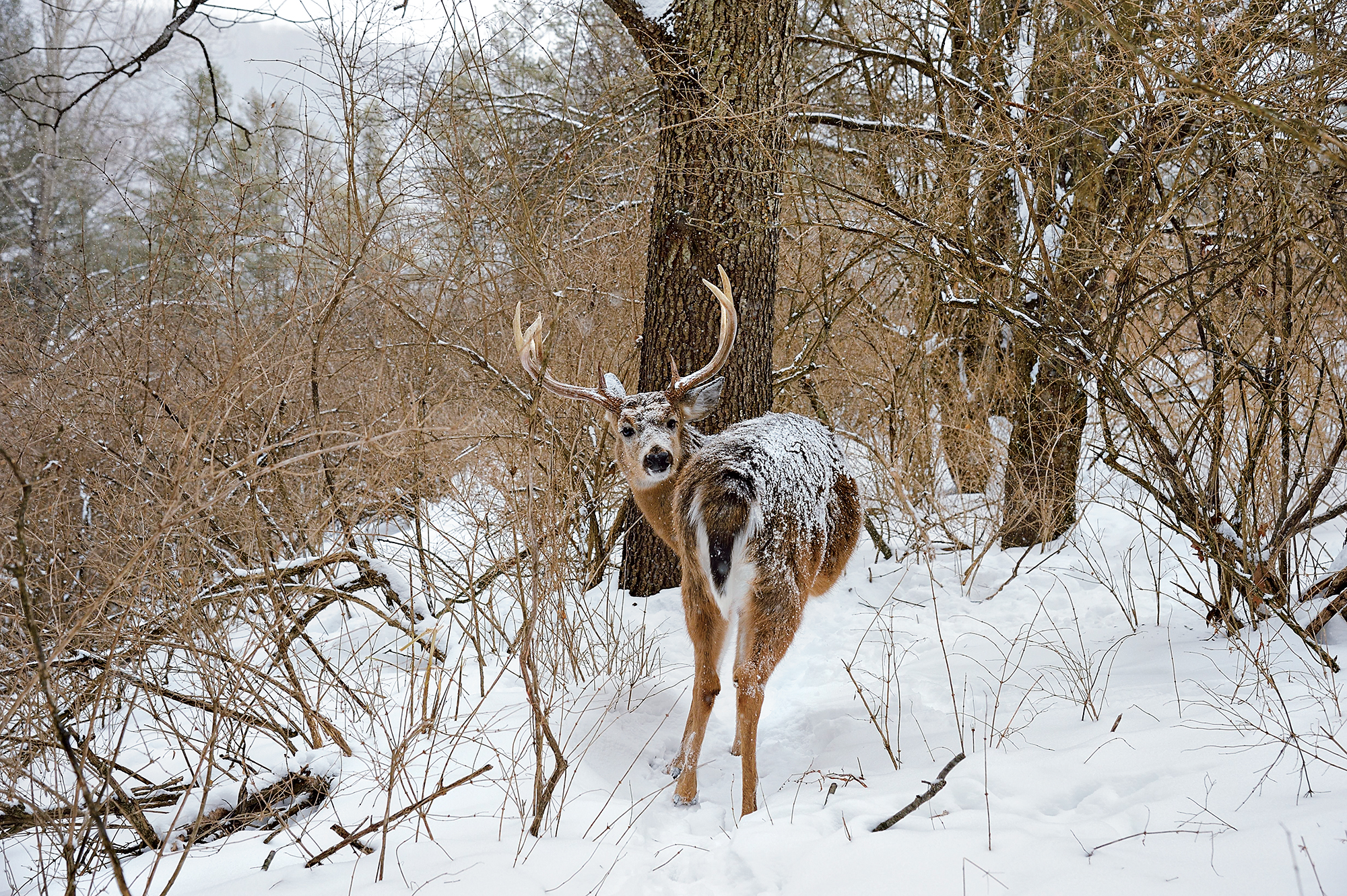
The Fast Track: The misstep that turned into a Thanksgiving celebration
It was Thanksgiving morning, and I was perched in the treestand where I had spent much of Maine’s rifle season. The difference this day was that 6 inches of snow had fallen overnight—and for me, that meant freedom. No longer would I be held prisoner by dry, crunchy conditions. If I wanted to get out of my stand and try still-hunting, I could do that. If I came across a track I wanted to follow, that was an option, too. Here was my chance to be more than a passive observer and make something happen.
With such thoughts in mind, the two hours that I forced myself to sit were torture. I was sure that deer were moving just out of sight. But when I finally climbed down and began exploring, it was like a nuclear winter: not a sign of life anywhere. I slipped into a nearby cedar swamp to see if I could catch something bedded. Nothing. I worked onto an oak ridge to see if I could find something feeding. Not a track.
Eventually I made it back to my truck, tired and discouraged. Just 5 miles from home, I decided to head in for lunch. I took the long way, driving the roads that surround my hunting area, and when I was about halfway there, I spied what I had been looking for: deer tracks. I skidded to a stop and jumped out to examine them. The single set crossed the road and headed into the block of woods where I’d spent the morning. The fact that they were on top of the snowplow’s tracks indicated that they were fairly new. Closer examination revealed a decent stride, staggered prints, and dragging hoof marks. A buck. I guessed that the deer was not a monster but certainly respectable for the coastal area I was hunting—and certainly worth following with three days left in the season.
If only all tracks were as easy to follow as these. Not only were they the only set in the area, but they also were heading steadily northeast, quartering into the wind. That said, there was the occasional diversion, as the tracks went around an overgrown foundation and even followed a brook for 75 yards, broken ice indicating where the deer had gone through a few times. When he had come upon several apple trees, he had pawed a bit beneath them, and then actually hooked a small spruce tree, the shavings on the snow confirming that I was following something with antlers.

I was confident that the deer did not know I was behind him, so I moved steadily through the open woods and slowed when the cover thickened. Each time I would look as far ahead on the track as I could, and then scan to each side as I proceeded along it.
Eventually the tracks led to where I dared not follow: a one-acre tangle of raspberry bushes, honeysuckle, and brambles. Read: bedding cover. Quietly wading in would be futile, so instead I opted to skirt the thicket by moving downwind through an overgrown field, pussyfooting as slowly as possible and looking to the interior for anything bedded. If the buck already had passed through, I would continue following on the other side. I had gotten halfway through the field when I heard a snort and saw a deer bust out of the cover headed for a nearby ridge. I threw my rifle to my shoulder, but when I found the deer in the scope I could see it had no antlers. At the top of the ridge, the doe stopped, turned to look back, and then walked stiff-legged out of sight.
I decided to see where the doe had come from, but I’d made it only 10 yards into the cover when I saw movement. Another deer was walking broadside at 40 yards, looking up the ridge after the doe. It was a buck. I slowly raised my rifle, and when the deer stepped clear of a thick deadfall, I settled the crosshairs behind his shoulder and squeezed the trigger.
At the shot, the buck turned and ran toward me. I jacked a second round into the chamber, but the red spray covering the snow indicated that a second shot was unnecessary. The deer ran another 25 yards before piling up.
After gutting the 8-point and calling home for help to drag the deer, I decided to reconstruct the events. Judging from the age of the tracks leading to her bed, it turns out that the doe had been in the thicket for some time. The buck was, indeed, the one I had been following, and he must have winded the doe and headed in after her. I was lucky to have arrived just before the two made contact, as the buck’s tracks never reached the doe’s bed. Had I come on the scene any later, the buck might already have chased the doe away and made my job a lot tougher.
Regardless, there was plenty to celebrate that evening at Thanksgiving dinner, which included a couple of backstraps. And the hunt confirmed why I love tracking as a way to make things happen.
—Ralph Stuart





